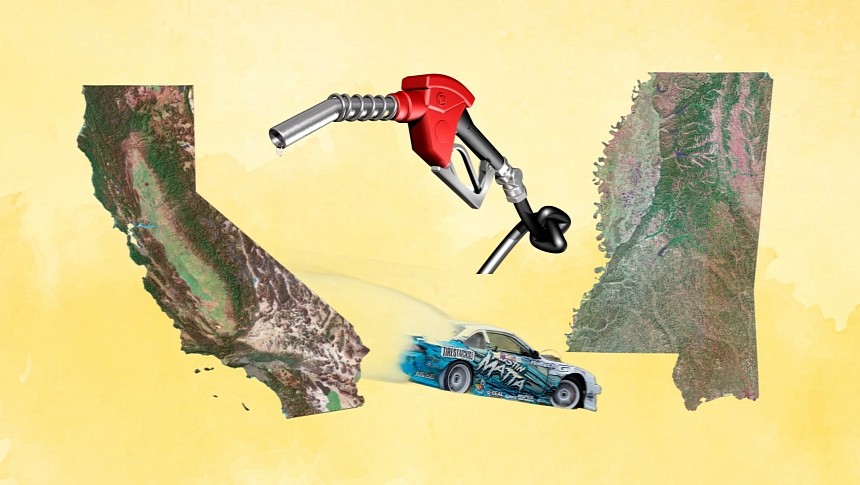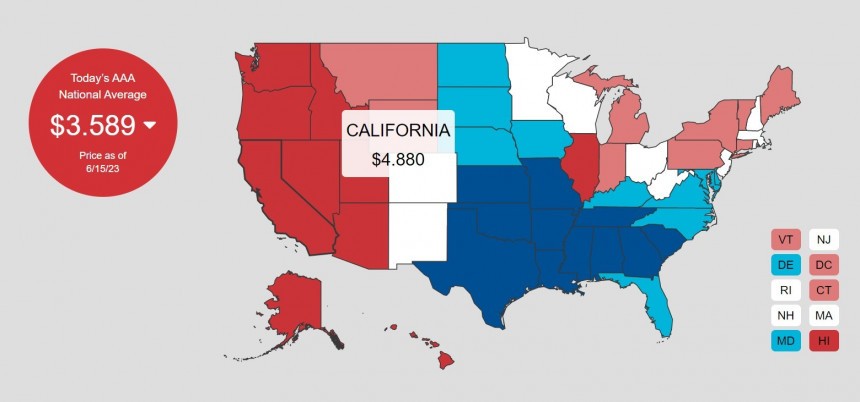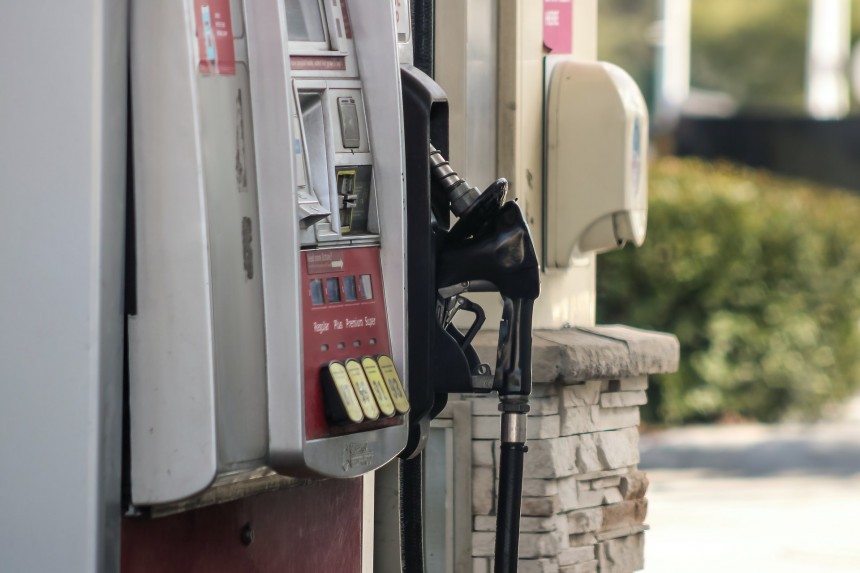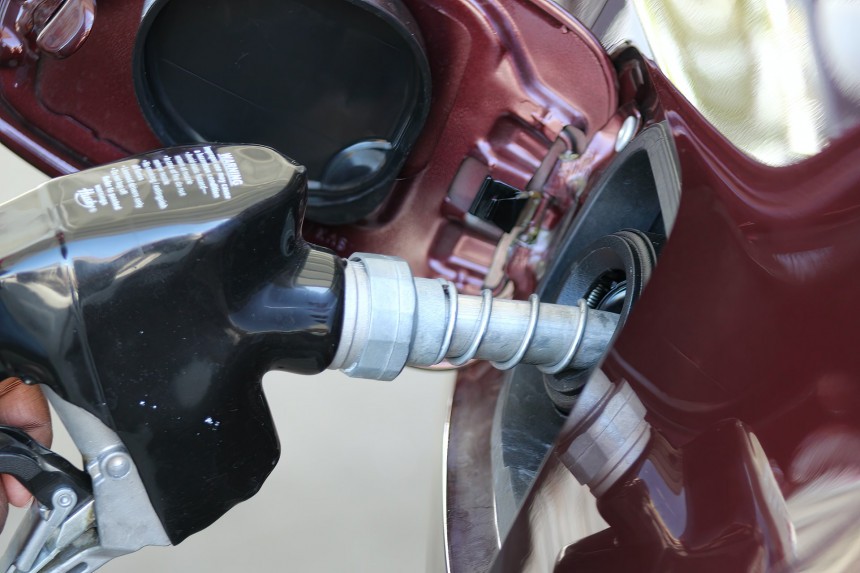One year ago, the national average price for a gallon of regular gas was $5.01, while diesel-powered vehicle owners were looking at $5.8 per gallon. Since then, we have come a long way, but not all Americans enjoy truly lowered prices. In California, for example, filling up remains a costly affair.
At the time of writing, the national average gas price is $3.58, approximately $1.50 cheaper than a year ago. We're heading in the right direction, but we're still not where most internal combustion engine vehicle drivers would like us to be. It's understandable, especially when we remind ourselves that a gallon of regular gas cost $2.60 on average four years ago.
But when looking at what people living in states like California or Mississippi pay for fuel, things might get confusing and even frustrating. The values seen at the pump by people living in the Golden State are still the highest in the country.
The average price for a gallon of regular gas in California is $4.88, while those living in the Magnolia State typically spend $3.00 for similar dinosaur juice. That means Mississippians pay approximately 63% less than Californians, according to the latest available data from the AAA. Even Hawaii has cheaper gas.
Mississippi's economy is smaller than California's, but the unemployment rate is 3.4% in the southeastern state, while on the West Coast, 4.5% of the abled population was not working in April 2023. But this might not be as relevant as some believe because California's gross domestic product (GDP) per capita is nearly double that of Mississippi. The Golden State also has around 36 million more inhabitants.
Moreover, Californians might be used by now to paying more for gas than other Americans. Last year, some fuel stations charged customers nearly $10 per gallon.
For California, it all boils down to taxes and environmental laws. People pay around $0.87 per gallon and state and federal taxes plus other fees. There's also a special blend of gasoline that theoretically reduces pollution, and not many suppliers are rushing to make and sell it. When the weather is warmer, the mix must change to keep exhaust fumes lower than the standard limit in other states.
Since the demand for gas in California is immense, the state's refineries must also work full-time. If just one doesn't run at total capacity, the supply shortens while the demand remains unchanged. Such an event may lead to temporary anomalies like what happened last year at a Shell station.
Businesses also have higher operational costs in the Golden State, which is another part of the final gas price supported by motorists.
More taxes, less competition, and infrastructure woes are the perfect storm that can lead to high prices. Consumers, ultimately, end up paying for everything.
There's no unique blend of gas in Mississippi during summer, and the tax is set at $0.18 per gallon.
Since the U.S. is the world's largest oil producer and consumer, we rely on what's happening globally. Sadly for gas- and diesel-powered vehicle owners, OPEC+ countries are steadily lowering their daily oil output. Saudi Arabia is championing this movement to maintain the product's price at an acceptable level because its economy still relies on fossil fuels.
Besides that, there are also worries about geopolitical instability, and global powers compete to change the status quo regarding monetary policies. If currencies weaken, economies follow suit.
But what matters most is international supply and demand. Gas prices will return to 2019 levels only if OPEC+ nations increase their output while consumption decreases. That's an unlikely scenario, especially as most automakers move towards hybridized and all-electric vehicles. As soon as major companies switch to cleaner or zero-tailpipe emission powertrains, fossil fuels will play a minor role on the global scale.
For now, though, we are in uncharted waters. A barrel of Brent crude oil costs around $11 less than it did three months ago, but traders act as soon as they sense something might be happening. Thus, there's no guarantee that we will see cheaper gas in the near future, and it's impossible to predict if we will have to deal with another situation like last year.
The only certainty that remains is taxes.
If you want to switch sides and take advantage of federal and state incentives, consider buying an electrified vehicle that qualifies for the updated EV tax credit. You're helping yourself by not paying for pricy gas and the environment by not releasing exhaust fumes into the air.
But when looking at what people living in states like California or Mississippi pay for fuel, things might get confusing and even frustrating. The values seen at the pump by people living in the Golden State are still the highest in the country.
The average price for a gallon of regular gas in California is $4.88, while those living in the Magnolia State typically spend $3.00 for similar dinosaur juice. That means Mississippians pay approximately 63% less than Californians, according to the latest available data from the AAA. Even Hawaii has cheaper gas.
Mississippi's economy is smaller than California's, but the unemployment rate is 3.4% in the southeastern state, while on the West Coast, 4.5% of the abled population was not working in April 2023. But this might not be as relevant as some believe because California's gross domestic product (GDP) per capita is nearly double that of Mississippi. The Golden State also has around 36 million more inhabitants.
So, what's going on?
Currently, America's divided when it comes to average gas prices. Those living on the West Coast pay over $4 for a gallon of regular, while Texas and its neighbors enjoy the lowest pump values possible today.For California, it all boils down to taxes and environmental laws. People pay around $0.87 per gallon and state and federal taxes plus other fees. There's also a special blend of gasoline that theoretically reduces pollution, and not many suppliers are rushing to make and sell it. When the weather is warmer, the mix must change to keep exhaust fumes lower than the standard limit in other states.
Since the demand for gas in California is immense, the state's refineries must also work full-time. If just one doesn't run at total capacity, the supply shortens while the demand remains unchanged. Such an event may lead to temporary anomalies like what happened last year at a Shell station.
Businesses also have higher operational costs in the Golden State, which is another part of the final gas price supported by motorists.
There's no unique blend of gas in Mississippi during summer, and the tax is set at $0.18 per gallon.
National focus, global outlook
National average gas prices remain on a slow uptrend. In May, a gallon of regular was priced at $3.53. Now, it's $0.05 more.Since the U.S. is the world's largest oil producer and consumer, we rely on what's happening globally. Sadly for gas- and diesel-powered vehicle owners, OPEC+ countries are steadily lowering their daily oil output. Saudi Arabia is championing this movement to maintain the product's price at an acceptable level because its economy still relies on fossil fuels.
Besides that, there are also worries about geopolitical instability, and global powers compete to change the status quo regarding monetary policies. If currencies weaken, economies follow suit.
For now, though, we are in uncharted waters. A barrel of Brent crude oil costs around $11 less than it did three months ago, but traders act as soon as they sense something might be happening. Thus, there's no guarantee that we will see cheaper gas in the near future, and it's impossible to predict if we will have to deal with another situation like last year.
The only certainty that remains is taxes.
If you want to switch sides and take advantage of federal and state incentives, consider buying an electrified vehicle that qualifies for the updated EV tax credit. You're helping yourself by not paying for pricy gas and the environment by not releasing exhaust fumes into the air.












